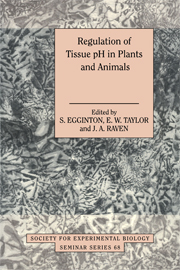Book contents
- Frontmatter
- Contents
- List of contributors
- Preface
- Measurement of intracellular pH: a comparison between ion-sensitive microelectrodes and fluorescent dyes
- pH-sensitive microelectrodes: how to use them in plant cells
- The use of nuclear magnetic resonance for examining pH in living systems
- Invasive studies of intracellular acid–base parameters: quantitative analyses during environmental and functional stress
- Lactate, H+ and ammonia transport and distribution in rainbow trout white muscle after exhaustive exercise
- Limiting factors for acid–base regulation in fish: branchial transfer capacity versus diffusive loss of acid–base relevant ions
- H+-mediated control of ion channels in guard cells of higher plants
- pH regulation of plants with CO2-concentrating mechanisms
- Intracellular pH regulation in plants under anoxia
- The role of turtle shell in acid–base buffering
- Acid–base regulation in crustaceans: the role of bicarbonate ions
- A novel role for the gut of seawater teleosts in acid–base balance
- pH and smooth muscle: regulation and functional effects
- Regulation of pH in vertebrate red blood cells
- Acid–base regulation in hibernation and aestivation
- Hepatic metabolism and pH in starvation and refeeding
- Back to basics: a plea for a fundamental reappraisal of the representation of acidity and basicity in biological solutions
- Index
The role of turtle shell in acid–base buffering
Published online by Cambridge University Press: 22 August 2009
- Frontmatter
- Contents
- List of contributors
- Preface
- Measurement of intracellular pH: a comparison between ion-sensitive microelectrodes and fluorescent dyes
- pH-sensitive microelectrodes: how to use them in plant cells
- The use of nuclear magnetic resonance for examining pH in living systems
- Invasive studies of intracellular acid–base parameters: quantitative analyses during environmental and functional stress
- Lactate, H+ and ammonia transport and distribution in rainbow trout white muscle after exhaustive exercise
- Limiting factors for acid–base regulation in fish: branchial transfer capacity versus diffusive loss of acid–base relevant ions
- H+-mediated control of ion channels in guard cells of higher plants
- pH regulation of plants with CO2-concentrating mechanisms
- Intracellular pH regulation in plants under anoxia
- The role of turtle shell in acid–base buffering
- Acid–base regulation in crustaceans: the role of bicarbonate ions
- A novel role for the gut of seawater teleosts in acid–base balance
- pH and smooth muscle: regulation and functional effects
- Regulation of pH in vertebrate red blood cells
- Acid–base regulation in hibernation and aestivation
- Hepatic metabolism and pH in starvation and refeeding
- Back to basics: a plea for a fundamental reappraisal of the representation of acidity and basicity in biological solutions
- Index
Summary
Introduction
The first line of defense of an organism against an acid load is the available endogenous buffering of its body fluids. These buffers bind most of the protons and greatly minimize the fall in pH. Conventional descriptions in vertebrates generally define two major buffering compartments, the extracellular fluid and the intracellular fluid. Extracellular fluid buffering is dominated by bicarbonate, with a minor contribution from plasma proteins; whereas in the intracellular compartment, non-bicarbonate buffers such as proteins and phosphates predominate.
Often neglected in a consideration of body buffers is the skeleton, even though this structure, with its rich reservoir of mineral phosphates and carbonates, is potentially the major source of buffering power in the body. Skeletal contribution to routine buffering, however, is often less important because of slow exchange kinetics with the extracellular fluid and because of inaccessibility of much of the bone mineral. Under certain circumstances, though, bone can play a central role in acid–base balance. In clinical cases of chronic nonrespiratory acidosis, skeletal buffers are heavily recruited and this response has led to extensive investigations of the role of bone in acid–base function in humans and other mammals. Normal stresses of animals can also produce acidotic states that involve skeletal buffers as, for example, in crustaceans in which hypoxic states can lead to lactate retention and dissolution of CaCO3 from their exoskeletons.
A dramatic and ecologically relevant example of bone involvement in acid buffering is the contribution of the shell of the freshwater turtle in neutralizing lactic acid produced during prolonged anoxic submergence by these animals.
- Type
- Chapter
- Information
- Regulation of Tissue pH in Plants and AnimalsA Reappraisal of Current Techniques, pp. 215 - 232Publisher: Cambridge University PressPrint publication year: 1999
- 2
- Cited by



